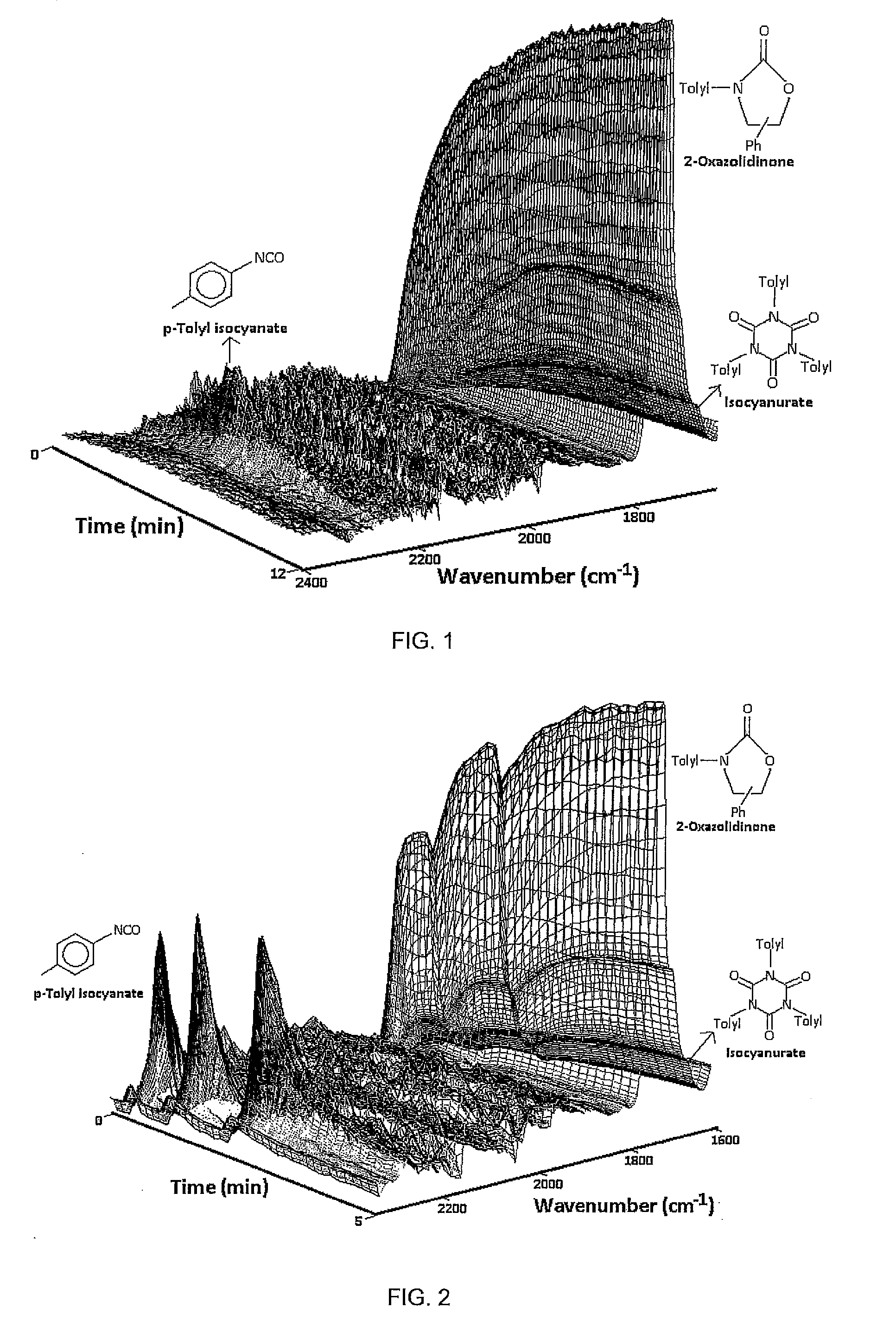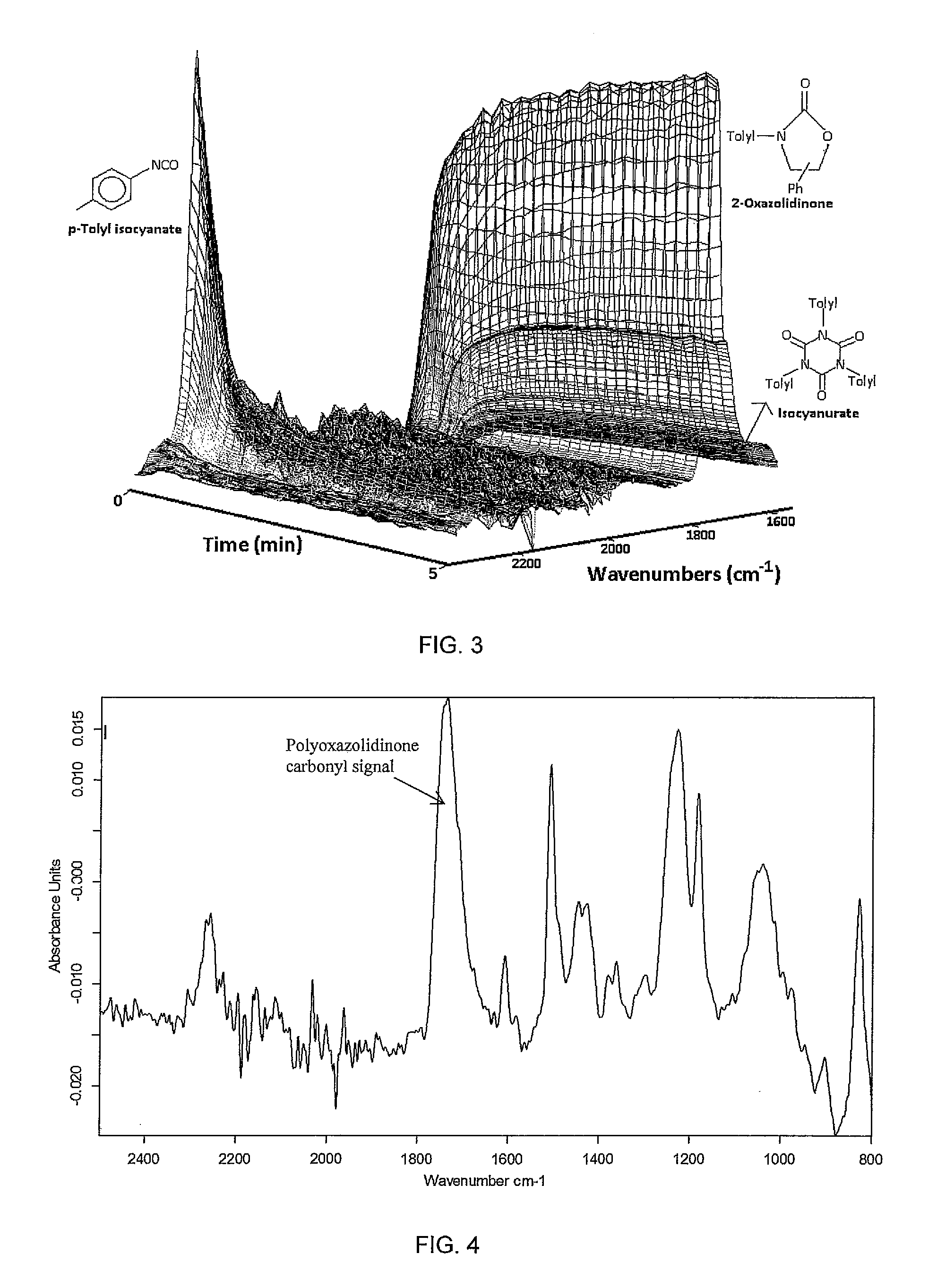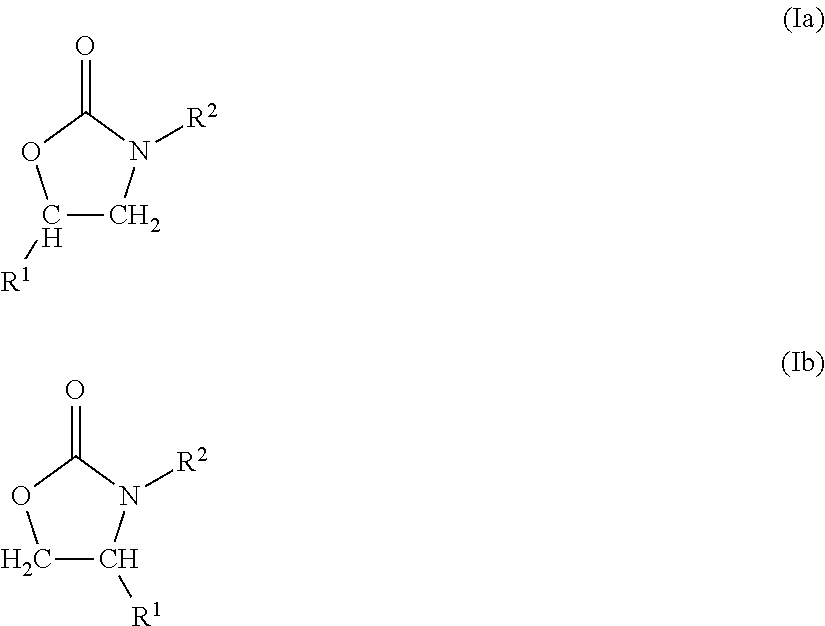Method for the production of oxazolidinone compounds
a technology of oxazolidinone and compound, which is applied in the field of method for the production of oxazolidinone compounds, can solve the problems of no disclosure, disadvantageous use of organotin compounds, and addition of isocyanate compounds
- Summary
- Abstract
- Description
- Claims
- Application Information
AI Technical Summary
Benefits of technology
Problems solved by technology
Method used
Image
Examples
example 1
Reaction of R-(+)-styrene oxide with para-tolyl isocyanate using SmI3 as catalyst with semi-batch addition of the isocyanate
[0109]Under a continuous flow of Argon (2.0 L / h), a glass flask (20 mL) was charged with SmI3 (46.57 mg, 0.0877 mmol) and R-(+)-styrene oxide (1.054 g, 8.77 mmol). The mixture was stirred (800 rpm) at room temperature for 10 min using a magnetic stirrer bar of 0.5 cm length. The flask was then placed into a hot oil bath set to 160° C. The IR probe was immersed into the reaction mixture and the IR spectrometer started. Para-tolyl isocyanate (1.168 g, 8.77 mmol) was added slowly at 0.2 mL / min. After all para-tolyl isocyanate had been added, stirring was continued until completion of the reaction was confirmed by the absence of the isocyanate band in the IR spectrum. The heating of the oil bath was switched off and the reaction mixture cooled to room temperature within of 30 min. The chemical composition of the reaction mixture was analysed.
[0110]During addition o...
example 2
Reaction of R-(+)-styrene oxide with para-tolyl isocyanate using SmI3 as catalyst with step-wise addition of para-tolyl isocyanate
[0114]Under a continuous flow of Argon (2.0 L / h), a glass flask (20 mL) was charged with SmI3 (46.57 mg, 0.0877 mmol) and R-(+)-styrene oxide (1.054 g, 8.77 mmol). The mixture was stirred (800 rpm) at room temperature for 10 min using a magnetic stirrer bar of 0.5 cm length. The flask was then placed into a hot oil bath set to 160° C. The IR probe was immersed into the reaction mixture and the IR spectrometer started. A first pulse of para-tolyl isocyanate (0.388 g, 2.92 mmol) was added quickly (within of 2 s) and the reaction mixture was stirred until completion of the reaction was indicated by disappearance of the isocyanate band. A second pulse of para-tolyl isocyanate (0.388 g, 2.91 mmol) was added quickly (within of 2 s) and the reaction mixture was stirred until completion of the reaction was indicated by disappearance of the isocyanate band. A thi...
example 4
Reaction of R-(+)-styrene oxide with para-tolyl isocyanate using LiBr as catalyst with semi-batch addition of the isocyanate
[0127]Under a continuous flow of Argon (2.0 L / h), a glass flask (20 mL) was charged with LiBr (7.61 mg, 0.0877 mmol) and R-(+)-styrene oxide (1.054 g, 8.77 mmol). The mixture was stirred (800 rpm) at room temperature for 10 min using a magnetic stirrer bar of 0.5 cm length. The flask was then placed into a hot oil bath set to 160° C. The IR probe was immersed into the reaction mixture and the IR spectrometer started. Para-tolyl isocyanate (1.168 g, 8.77 mmol) was added slowly at 0.2 mL / min. After all para-tolyl isocyanate had been added, stirring was continued until completion of the reaction was confirmed by the absence of the isocyanate band in the IR spectrum. The heating of the oil bath was switched off and the reaction mixture cooled to room temperature within of 30 min. The chemical composition of the reaction mixture was analysed.
[0128]During addition of...
PUM
| Property | Measurement | Unit |
|---|---|---|
| Temperature | aaaaa | aaaaa |
| Temperature | aaaaa | aaaaa |
| Percent by mass | aaaaa | aaaaa |
Abstract
Description
Claims
Application Information
 Login to View More
Login to View More - R&D
- Intellectual Property
- Life Sciences
- Materials
- Tech Scout
- Unparalleled Data Quality
- Higher Quality Content
- 60% Fewer Hallucinations
Browse by: Latest US Patents, China's latest patents, Technical Efficacy Thesaurus, Application Domain, Technology Topic, Popular Technical Reports.
© 2025 PatSnap. All rights reserved.Legal|Privacy policy|Modern Slavery Act Transparency Statement|Sitemap|About US| Contact US: help@patsnap.com



